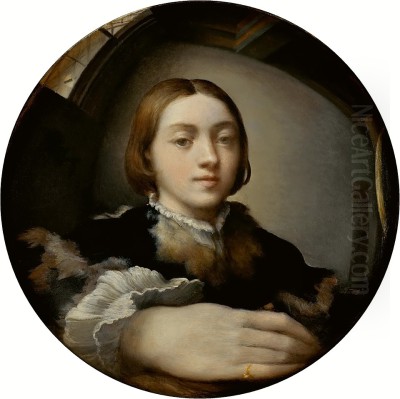
Girolamo Francesco Maria Mazzola, universally known by his nickname Parmigianino, meaning "the little one from Parma," stands as one of the most intriguing and influential figures of the Italian High Renaissance and Mannerist periods. Born in Parma on January 11, 1503, and dying tragically young in Casalmaggiore on August 24, 1540, his relatively short life produced an extraordinary body of work characterized by sophisticated elegance, technical brilliance, and a distinctive departure from classical norms. As a painter and a pioneering printmaker, Parmigianino carved a unique path, leaving an indelible mark on the course of European art. His work embodies the grace, complexity, and sometimes unsettling beauty of Mannerism, a style he helped to define.
Early Life and Artistic Formation in Parma
Parmigianino was born into an artistic milieu. His father, Filippo Mazzola, was a painter of some local repute, though he died when Girolamo was only two years old. Following his father's death, the young Parmigianino was raised and trained by his paternal uncles, Michele and Pier Ilario Mazzola, who were also painters running a workshop in Parma. Growing up surrounded by the tools and discussions of the painter's craft undoubtedly nurtured his innate talents, which became evident at a remarkably early age. Parma itself was becoming an important artistic center, largely due to the presence of Antonio Allegri da Correggio, whose work would profoundly impact the young artist.
Even in his teenage years, Parmigianino demonstrated exceptional skill. Early commissions included work in local churches. He contributed, for instance, to the decoration of the church of San Giovanni Evangelista in Parma around 1521-22. While there, he would have closely observed the work of Correggio, who was famously painting the dome frescoes depicting the Ascension of Christ and the Vision of St. John on Patmos. Although never formally documented as Correggio's pupil, Parmigianino absorbed much from the elder master's soft sfumato, graceful figures, and dynamic compositions. Correggio's influence is palpable in the sweetness and fluidity found in Parmigianino's early works, though the younger artist quickly began to develop his own, more stylized and artificial elegance.
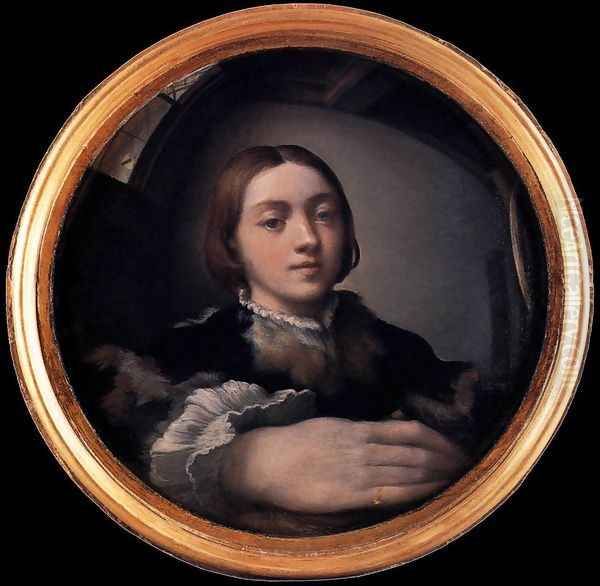
His precocity was noted by contemporaries. Giorgio Vasari, the famed biographer of Renaissance artists, recounts Parmigianino's early achievements, highlighting his natural facility and the speed with which he mastered complex techniques. Even before leaving Parma, he had established a reputation for possessing a unique artistic vision, one that blended the lessons learned from local masters with an inherent drive towards refinement and sophistication that would become his hallmark.
The Roman Sojourn: Influence and Acclaim
In 1524, at the age of 21, Parmigianino made the pivotal decision to travel to Rome. This move was crucial for any ambitious artist of the period, as Rome was the epicenter of the High Renaissance, dominated by the towering legacies of Raphael (who had died in 1520) and the ongoing work of Michelangelo. Parmigianino arrived bearing gifts intended to impress potential patrons, including several small paintings. Among these was his famous Self-portrait in a Convex Mirror, a technical marvel showcasing his virtuosity and fascination with optical effects and distortion – already hinting at his Mannerist inclinations.
Rome proved transformative. Parmigianino immersed himself in the study of both classical antiquity and the works of the High Renaissance masters. He was particularly captivated by the grace and harmonious compositions of Raphael, whose influence tempered his earlier Correggesque style. So adept was he at absorbing and reinterpreting Raphael's elegance that, according to Vasari, some observers hailed him as the reincarnation of the Urbino master – "Raphael reborn." This period saw him refine his draughtsmanship and develop a more monumental approach to figure painting, though always filtered through his own lens of sophisticated artificiality.
During his Roman years (1524-1527), Parmigianino produced significant works, including The Vision of Saint Jerome (1527), now housed in the National Gallery, London. This altarpiece, with its elongated figures, dynamic composition, and dramatic lighting, exemplifies his mature Roman style, blending Raphaelesque grandeur with a distinctly Mannerist sensibility. He also associated with other artists active in Rome who were exploring similar stylistic avenues, such as Rosso Fiorentino and Giulio Romano, Raphael's principal heir. These interactions likely reinforced his move towards a more stylized and anti-classical aesthetic.
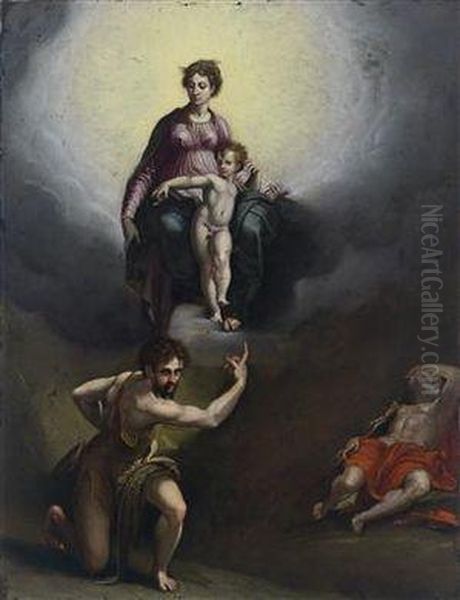
Parmigianino's promising Roman career was abruptly cut short by the catastrophic Sack of Rome in 1527. Imperial troops mutinied and brutally pillaged the city, creating chaos and ending the vibrant cultural climate of the High Renaissance papacy. Vasari recounts that Parmigianino was so engrossed in his work that soldiers burst into his studio, but were supposedly so struck by the beauty of his paintings that they spared him, demanding only drawings. Nevertheless, the event forced him, like many other artists, to flee the devastated city.
Bologna and the Art of Printmaking
Seeking refuge after the trauma of the Sack of Rome, Parmigianino settled in Bologna around 1527, remaining there for about three or four years. This period proved highly productive, particularly in the field of printmaking. While he continued to paint, receiving commissions for works like the Madonna and Child with Saints (Pinacoteca Nazionale, Bologna), his time in Bologna is especially noted for his exploration of etching. Parmigianino was one of the first Italian artists to fully exploit the potential of etching not just as a reproductive medium, but as an original art form capable of conveying the fluidity and spontaneity of drawing.
His etchings, such as the enigmatic Diogenes (c. 1527-30), are characterized by elegant, flowing lines, delicate hatching, and atmospheric effects that capture light and shadow with remarkable subtlety. He often worked from his own drawings, translating their grace and energy into the etched line. His technical innovations and the sheer beauty of his prints significantly elevated the status of etching in Italy.
During his time in Bologna, Parmigianino also collaborated with other printmakers. He is known to have worked with Ugo da Carpi, a master of the chiaroscuro woodcut technique, and possibly provided designs for printmakers like Antonio da Trento. These collaborations further disseminated his distinctive style and compositions to a wider audience across Italy and Europe. His prints became highly sought after by collectors and served as models for other artists, contributing significantly to the spread of Mannerist aesthetics. This focus on printmaking demonstrates his versatility and his keen understanding of how different media could serve his artistic vision.
Return to Parma and Later Years: Triumph and Trouble
Around 1530 or 1531, Parmigianino returned to his native Parma, now a celebrated artist. He soon received his most prestigious commission: the fresco decoration of the apse and barrel vault of the newly built church of Santa Maria della Steccata, a prominent Marian sanctuary in the city. The contract, signed in 1531, stipulated that the work should be completed within eighteen months. This commission represented a major opportunity, placing him in the lineage of Correggio, who had decorated Parma's major domes.
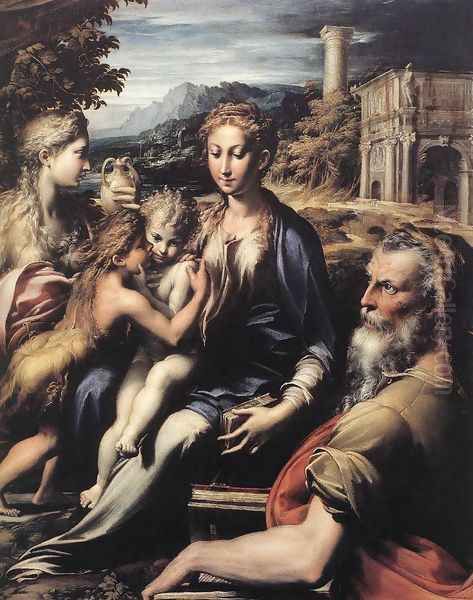
However, the Steccata project became fraught with difficulties. Parmigianino worked sporadically on the frescoes, completing only a portion of the vault decoration, famously featuring the Wise and Foolish Virgins. His progress was slow, far exceeding the agreed-upon deadline. The reasons for the delay are debated. Vasari famously attributed it to Parmigianino's growing obsession with alchemy, suggesting he neglected his painting duties in futile attempts to transmute base metals into gold. While the extent of his alchemical pursuits is uncertain, it's clear he struggled to fulfill the contract.
The confraternity overseeing the Steccata grew increasingly impatient. After repeated warnings and extensions, they eventually took legal action against Parmigianino in 1539. He was briefly imprisoned for breach of contract and ultimately dismissed from the project. The remaining frescoes were later completed by other artists, including, significantly, Giulio Romano, who was called in after Parmigianino's departure, and eventually Michelangelo Anselmi. This episode tarnished his reputation in Parma and marked a difficult period in his later life. It perhaps reflects a certain temperament, a perfectionism or restlessness that made large, long-term projects challenging for him, despite his immense talent.
Despite the Steccata debacle, Parmigianino continued to produce masterpieces during this final decade. It was during the 1530s that he painted some of his most iconic works, including the highly stylized and enigmatic Madonna with the Long Neck (c. 1534-40, Uffizi, Florence) and the sensual Cupid Making a Bow (c. 1533-34, Kunsthistorisches Museum, Vienna). He also painted sophisticated portraits, such as the celebrated Portrait of Antea (c. 1531-34, Capodimonte Museum, Naples). The identity of Antea remains a subject of debate – was she a famous Roman courtesan, a Parmese noblewoman, or simply an idealized figure? Regardless, the portrait is a stunning example of Mannerist elegance and psychological nuance. His cousin, Girolamo Bedoli (also known as Girolamo Mazzola Bedoli), became his close follower and sometimes collaborator during this period, inheriting his workshop and occasionally having his own works attributed to the more famous master.
Disillusioned and possibly seeking refuge from his legal troubles in Parma, Parmigianino moved to the nearby town of Casalmaggiore. It was there, in August 1540, that he died suddenly of a fever, aged only 37. According to Vasari, he wished to be buried "naked, with a cross of cypress wood upright on his breast." His premature death cut short a career that, despite its brevity, had already reshaped the landscape of Italian art.
Artistic Style and Mannerism

Parmigianino is considered a central figure, perhaps the epitome, of Italian Mannerism. Mannerism emerged in the 1520s, partly as a reaction against the harmonious ideals and naturalism of the High Renaissance as practiced by artists like Leonardo da Vinci, Raphael, and the early Michelangelo. Mannerist artists sought sophistication, artifice, and elegance, often prioritizing beauty and complexity over natural representation. Parmigianino's work perfectly encapsulates these tendencies.
His style is immediately recognizable for its grace and refinement. Figures are often elongated, with impossibly long necks, slender limbs, and small heads perched delicately atop elegant bodies. They adopt complex, twisting poses – the figura serpentinata (serpentine figure) – that emphasize grace and movement, even when at rest. This can be seen clearly in works like the Madonna with the Long Neck, where the Virgin's proportions are deliberately distorted for aesthetic effect.
Parmigianino's compositions are often intricate and spatially ambiguous. He rejected the clear, balanced structures of the High Renaissance in favor of asymmetrical arrangements, unexpected juxtapositions of scale, and compressed or undefined spaces. His color palettes tend towards cool, artificial tones – pale blues, pinks, greens, and grays – applied with a smooth, enamel-like finish that enhances the sense of unreality and polished artifice.
His portraits are renowned for their psychological intensity and aristocratic detachment. Sitters are presented with an air of sophisticated nonchalance, often adorned in luxurious fabrics rendered with meticulous detail. While capturing a likeness, Parmigianino imbued his portraits with an idealized elegance and a certain enigmatic quality, as seen in the Portrait of Antea or the Portrait of Galeazzo Sanvitale.
His approach was highly intellectual and self-conscious. Parmigianino explored the nature of art itself, playing with perspective (as in the Self-portrait in a Convex Mirror), exaggerating natural forms, and prioritizing artistic invention over imitation of nature. This conscious cultivation of a unique, sophisticated style – his maniera – is the essence of Mannerism, and Parmigianino practiced it with unparalleled skill and originality.
Key Works Analysis
Several works stand out as defining examples of Parmigianino's unique artistic vision:
Self-portrait in a Convex Mirror (c. 1524): Painted on a specially prepared convex wooden panel, this work demonstrates Parmigianino's technical brilliance and fascination with illusion and distortion. The enlarged hand in the foreground and the warped reflection of the room showcase his Mannerist interest in artifice and complex visual effects, while the youthful artist gazes out with serene confidence.
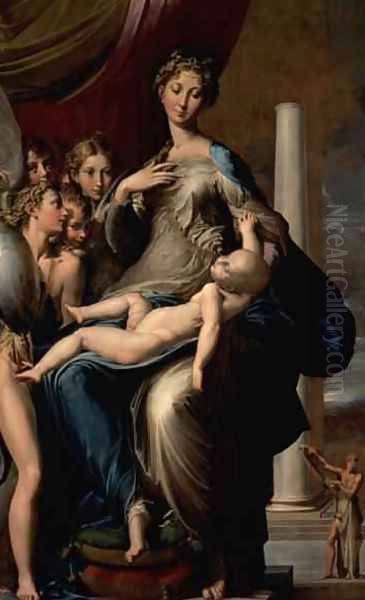
The Vision of Saint Jerome (1527): Commissioned during his Roman period, this altarpiece depicts Saint John the Baptist in the foreground pointing towards a sleeping Saint Jerome, above whom the Madonna and Child appear in a radiant vision. The figures are elongated and arranged in a dynamic, diagonal composition. The dramatic lighting, intense colors, and combination of muscularity (influenced by Michelangelo) and grace make it a powerful statement of his early Mannerist style.
Madonna with the Long Neck (c. 1534-40): Perhaps his most famous work, this painting is a quintessential example of Mannerism. The Virgin Mary possesses an unnaturally elongated neck and fingers, cradling an equally elongated Christ Child who lies precariously across her lap. On the left, a crowd of angels with ambiguous features crush together, while on the right, a vast, unfinished architectural space features a diminutive figure of Saint Jerome unrolling a scroll near a prominent, enigmatic column. The painting's irrational space, distorted proportions, cool sensuality, and unresolved symbolism continue to fascinate and provoke discussion. It remained unfinished at his death.
Portrait of Antea (c. 1531-34): This captivating portrait depicts a young woman sumptuously dressed, gazing directly at the viewer with a calm but inscrutable expression. The meticulous rendering of her attire, the refined features, and the air of aristocratic poise are characteristic of Parmigianino's portraiture. The ongoing debate about her identity – courtesan, noblewoman, or idealized beauty – adds to the portrait's allure and reflects the complex social dynamics of the era.
Parmigianino the Draftsman and Printmaker
Parmigianino's genius extended beyond painting; he was also one of the most gifted draftsmen and innovative printmakers of his time. A large number of his drawings survive, executed in various media including red and black chalk, pen and ink, and wash. These drawings reveal his creative process, showcasing his fluid line, his ability to capture movement and grace, and his constant experimentation with composition and form. They range from quick sketches exploring initial ideas to highly finished studies for paintings or prints. His drawings were highly prized even during his lifetime and were collected avidly.
His contribution to printmaking, particularly etching, was groundbreaking. While German artists like Albrecht Dürer had explored etching earlier, Parmigianino was among the first Italians to fully embrace its artistic potential. He used the etching needle with the freedom and fluidity of a pen, creating prints that mirrored the spontaneity and elegance of his drawings. His delicate lines and subtle tonal variations achieved remarkable atmospheric effects.
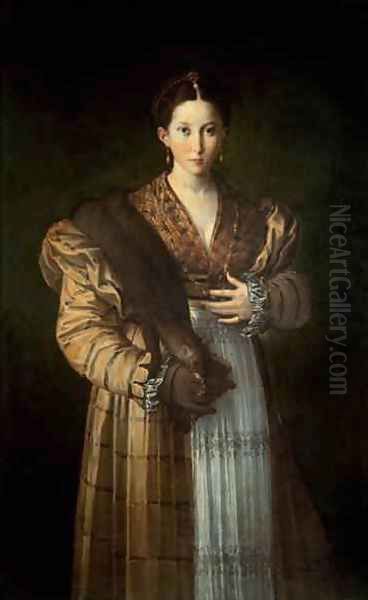
His prints, often depicting mythological or allegorical subjects, were instrumental in disseminating his style throughout Italy and Northern Europe. They influenced generations of printmakers, including later Italian masters like Federico Barocci. His pioneering work helped establish etching as a major medium for original artistic expression, distinct from the more laborious process of engraving.
Legacy and Influence
Despite his short life, Parmigianino's impact on the history of art was profound and lasting. He was a pivotal figure in the development and dissemination of the Mannerist style, offering a sophisticated alternative to the High Renaissance classicism. His emphasis on elegance, artifice, and psychological complexity resonated deeply with the aristocratic tastes of the time.
His influence extended geographically and chronologically. His elegant figure style and decorative sensibility were particularly influential on the School of Fontainebleau in France, where artists like Francesco Primaticcio (who had worked with Giulio Romano) helped shape French Mannerism. His prints circulated widely, ensuring his compositions and stylistic innovations were known to artists across Europe.
Later artists continued to study and admire his work. The Bolognese painters of the late 16th and early 17th centuries, particularly the Carracci family (Annibale Carracci and Agostino Carracci), held his drawings and prints in high regard, recognizing his mastery of form and grace even as they sought to move beyond Mannerism towards the Baroque. His sophisticated portraiture influenced the development of courtly portrait painting in subsequent centuries.
Parmigianino remains a compelling figure – an artist of extraordinary talent whose work embodies the transition from the confidence of the High Renaissance to the more complex, introspective, and stylized world of Mannerism. His pursuit of an intensely personal and refined aesthetic resulted in some of the most elegant and hauntingly beautiful images in Western art.
Conclusion
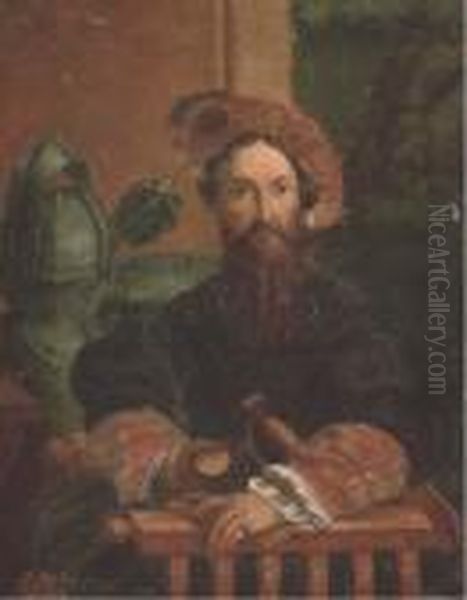
Girolamo Francesco Maria Mazzola, Parmigianino, was more than just "the little one from Parma." He was a giant of Mannerism, an artist whose pursuit of grace, sophistication, and technical perfection resulted in a body of work that continues to captivate and inspire. From his early absorption of Correggio's softness to his engagement with Roman grandeur and his later development of a uniquely elegant and artificial style, his artistic journey was one of constant innovation. As a painter, draftsman, and pioneering etcher, he left an indelible mark on sixteenth-century art and influenced generations that followed. His tragically short life yielded a legacy of exquisite beauty and complex artistry, securing his place as one of the most original masters of the Italian Renaissance.